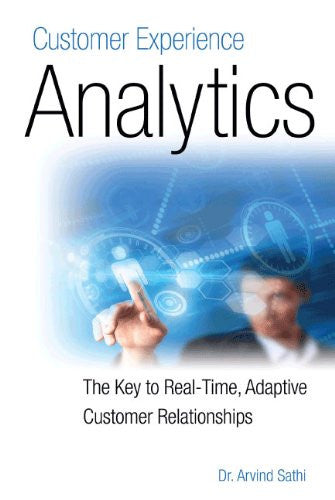Editor's Note: This article is an excerpt from the book Customer Experience Analytics published by MC Press.
Large automation investments in customer touch points, products, and business processes are rapidly creating enormous volumes of data as well as capabilities to make changes at electronic speeds. This chapter explores these changes in "instrumentation" and how they provide an environment for Customer Experience Analytics (CEA).
IVR, kiosks, mobile devices, email, chat, corporate web sites, third-party applications, and social networks have generated a fair amount of event information about our customers. In addition, customer interaction via traditional media, such as call centers, can now be analyzed and organized. The biggest change is in our ability to modify the customer experience using software (policies, procedures, and personalization), making self-service increasingly customer-friendly. The availability of raw data about customers provides an unprecedented opportunity not only to analyze and understand the customer but also to adaptively change customer-facing systems and processes to improve customer experience.
Sales and Marketing
Analytics related to customers and their experiences has been a widely studied area for over 50 years. Most of the core marketing science and related disciplines developed models of customer behavior, devised ways to measure customer experience, and used analytics to peek into the decision-making process. While academics worked on very impressive customer models and techniques for analysis and prediction, it was often difficult to apply these principles in practice, because of a lack of and high cost of data collection.
The good news is that all the work in marketing science can now be applied as the data becomes available. To that definition, I would like to add the tasks associated with data ingestion, categorization, and management to support the analytics.
Sales and marketing got their biggest boost in instrumentation from Internet-driven automation over the past 10 years. Browsing, shopping, ordering, and customer service on the web has not only provided tremendous control to end users; it has also created an enormous flood of information to the marketing, product, and sales organization in understanding buyer behavior. Each sequence of web clicks can be collected, collated, and analyzed for customer delight, puzzlement, dysphoria, or outright defection and the sequence leading to this decision.
Self-service has crept in through a variety of means: IVRs, kiosks, handheld devices, and many others. Each of these electronic means of communication acts like a gigantic pool of time-and-motion studies. We have data available on how many steps a customer took, how many products she compared, and what she focused on: price, features, brand comparisons, recommendations, defects, and so on. Suppliers have gained enormous amounts of data from self-service, electronic leashes connected to products, and the use of IT. If I use a two-way set-top box to watch television, the supplier has instant access to my channel-surfing behavior. Did I change the channel when the advertisement started? Did I turn the volume up or down when the jingle started to play? If I use the Internet to shop for a product, my click stream can be analyzed and used to study shopping behavior. How many products did I look at? What did I view in each product? Was it the product description or the price? This enriched set of data allows us to analyze customer experience in the minutest detail.
What are the sources of data from such self-service interactions?
- Product—As products become increasingly electronic, they provide a lot of valuable data to the supplier regarding product use and product quality. In many cases, suppliers can also collect information about the context in which a product was used. Products can also supply information related to frequency of use, interruptions, usage skipping, and other related aspects.
- Electronic touch points—A fair amount of data can be collected from the touch points used for product shopping, purchase, use, or payment. IVR tree traversals can be logged, web click streams can be collected, and so on.
- Components—Sometimes, components may provide additional information. This information could include data about component failures, use, or lack thereof. For example, a wireless telecommunications provider can collect data from networks, cell towers, third parties, and handheld devices to understand how all the components together provided a good or bad service to the customer.
As much as we have used instrumentation to collect rich amounts of customer data, CEA can also be used to drive a new set of behaviors. Over the past 30 years, we have seen gradual maturing of our understanding of CEA and how it impacts sales and marketing. The early evolution was in use of CEA for segmentation. The original segmentations were demographic in nature and used hard consumer data—such as geography, age, gender, and ethnic characteristics—to establish market segmentations. Marketers soon realized that behavioral traits were important parameters to segment the customers.
As our understanding grew, we saw more emphasis on micro segments—specific niche markets based on CEA-driven parameters. For example, marketers started to differentiate innovators and early adapters, as compared with late adapters, in their willingness to purchase new electronic gadgets. Customer experience data let us characterize innovators who were eager to share experiences and were more tolerant of product defects.
In the mid-1990s, with automation in customer touch points and use of the Internet for customer self-service, marketing started to get interested in personalization and 1:1 marketing. As Martha Rogers and Don Peppers point out in their book The One to One Future, "The basis for 1:1 marketing is share of customer, not just market share. Instead of selling as many products as possible over the next sales period to whomever will buy them, the goal of the 1:1 marketer is to sell one customer at a time as many products as possible over the lifetime of that customer's patronage. Mass marketers develop a product and try to find customers for that product. But 1:1 marketers develop a customer and try to find products for that customer."
Early CEA systems were reporting systems that provided raw segmentation data to the marketing team so that they could use the data to decide on marketing activities, such as campaigns. Automation in marketing and operations gave us the opportunity to close the loop—use CEA to collect effectiveness data to revise and improve campaigns. We are seeing surges in campaign activity. Marketers are interested in micro-campaigns that are designed specifically for a micro-segment or, in some cases, for specific customers. The customer experience information gives us criteria for including a customer in the campaign.
For example, prepaid wireless providers are engaging in micro-campaigns targeted at customers who are about to run out of their prepaid minutes. These customers are the most likely to churn to a competitor and could easily continue with their current wireless provider if they were to be directed to a store that sells prepaid wireless cards.
Another area of interest is Next Best Action (NBA)—in other words, recommending an activity based on the customer's latest experience with the product. This could include an up-sell/cross-sell based on current product ownership, usage level, and behavioral profile. NBA could be offered any time the sales organization has the opportunity to connect with the customer via a touch point. NBA is far more effective in sales conversion compared with canned rules that repeatedly offer the same product over and over across a customer interaction channel. (Imagine your airline offering you a discounted trip to your favorite warm-weather golf vacation spot on a cold day.) NBA can also be revised based on feedback from customer reaction.
Pricing has been a hotly pursued topic for business, as each percent increase in price without a corresponding decrease in demand means an increase in profits. There has been a growing trend to use price optimization models—mathematical programs that calculate how demand varies at different price levels—and then combine that data with information about costs and inventory levels to recommend prices that will improve profits. Given the complexity of pricing and the thousands of items in highly dynamic market conditions, modeling results and insights helps to forecast demand, develop pricing and promotional strategies, control inventory levels, and improve customer satisfaction.















 Business users want new applications now. Market and regulatory pressures require faster application updates and delivery into production. Your IBM i developers may be approaching retirement, and you see no sure way to fill their positions with experienced developers. In addition, you may be caught between maintaining your existing applications and the uncertainty of moving to something new.
Business users want new applications now. Market and regulatory pressures require faster application updates and delivery into production. Your IBM i developers may be approaching retirement, and you see no sure way to fill their positions with experienced developers. In addition, you may be caught between maintaining your existing applications and the uncertainty of moving to something new. IT managers hoping to find new IBM i talent are discovering that the pool of experienced RPG programmers and operators or administrators with intimate knowledge of the operating system and the applications that run on it is small. This begs the question: How will you manage the platform that supports such a big part of your business? This guide offers strategies and software suggestions to help you plan IT staffing and resources and smooth the transition after your AS/400 talent retires. Read on to learn:
IT managers hoping to find new IBM i talent are discovering that the pool of experienced RPG programmers and operators or administrators with intimate knowledge of the operating system and the applications that run on it is small. This begs the question: How will you manage the platform that supports such a big part of your business? This guide offers strategies and software suggestions to help you plan IT staffing and resources and smooth the transition after your AS/400 talent retires. Read on to learn:
LATEST COMMENTS
MC Press Online